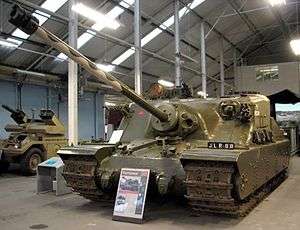Ordnance QF 32-pounder
The Ordnance QF 32 pounder or (32-pdr) was a British 94 mm gun, initially developed as a replacement for the Ordnance QF 17-pdr anti-tank gun.
| Ordnance QF 32-pounder | |
|---|---|
 The 32-pdr mounted in the Assault Tank A39 Tortoise | |
| Type | Gun |
| Place of origin | United Kingdom |
| Service history | |
| Used by | British |
| Wars | Second World War |
| Specifications | |
| Mass | 2,972 kg (6,552 lb) |
| Calibre | 94 mm |
| Muzzle velocity | 5,000 feet per second (1,500 m/s) |
| Effective firing range | 1,350 yards (1,230 m) |
| Maximum firing range | 5,000 yards (4,600 m) |
Development
Development started in October 1942, due to a General Staff order for a successor to the 17-pdr.[1] Basic requirements involved the new gun to be "at least 25% more effective" than the 17-pdr. Initial focus was on development of a 55-pdr gun, however advancements in 17-pdr ammunition meant the benefits achieved by the 55-pdr were no longer as valid, and with considerable disadvantages such as handling and stowage of ammunition. Other options included a 76 mm (3-inch) 17-pdr firing Armour Piercing Composite Rigid (APCR) shot weighing 4 lb (1.8 kg) with a muzzle velocity of 3,550 ft/s (1,080 m/s)[1] a 3"/2.25 Littlejohn (tapered barrrel) firing a 3.5 lb (1.6 kg) Armour-Piercing, Composite Non-Rigid (APCNR) shot at 4,500 ft/s and a 30-pdr gun of 3.45 in (88 mm) calibre.[1] Eventually, a 30pdr, 3.7-inch gun was proposed for a standard calibre, as it had a better margin for improvement.[2] The QF 3.7-inch AA gun was selected as the basis for the 30-pdr anti-tank gun in September 1943 and for pilots to be built. During development, it was proposed that a 37 lb shot would give better performance, and this new design was trialled as the QF 37 pdr EX1 in June 1944. Following firing trials, the 37 lb shot was dropped for a 32 lb shot, and the gun was accepted as the QF 32-pdr.
At least one 32-pdr was developed as an anti-tank gun on a wheeled carriage and a single example using a novel form of muzzle brake was installed in a de Havilland Mosquito FB Mk. XVIII as an up-gunned version of the 'Tsetse', in place of the (6-pdr) 57 mm Molins gun. While flight trials did not take place until after the war had ended, the aircraft flew and the gun fired without problems.[3]
The 32-pdr fired a 32 lb (14.5 kg) armour-piercing shot at a muzzle velocity of 2,880 ft/s (877.8 m/s) and a 15.3 lb (6.9 kg) Armour-piercing discarding sabot (APDS) shot at a muzzle velocity of 5,050 ft/s (1,540 m/s).
During firing trials on 28 June 1945, the 32-pdr Shot Mk.3 APDS shot could penetrate 200 mm (7.9 in) RHA at 50° - a line of sight equivalent of 311 mm (12.2 in) at the velocity of 1,487 m/s on impact, which meant that its penetration was more than 17-pdr and 20-pdr APDS rounds, and could even rival early Armour-piercing fin-stabilized discarding sabot (APFSDS) rounds in raw penetration. The front hull of the Tiger II (Konigstiger) and Jagdtiger could be penetrated easily by the 32-pdr gun, and it would have been the only anti-tank gun that could do so in the Second World War. By comparison the M308 HVAP shell (used in the 90 mm M3 anti-tank gun on the M36 GMC) could only penetrate 114 mm (4.5 in) at 50-degrees at 100 yards.
Development was halted with the end of the war, and the 17-pdr was replaced with the 20-pdr for tank use, the 120mm BAT recoilless rifle for anti-tank use, and the intention to replace it with Anti-tank guided missiles for infantry-use.
References
- Shillito, Chris (2001). "Armour in Focus: A39 Tortoise Heavy Assault Tank". Armour in Focus. Archived from the original on 6 May 2019. Retrieved 21 November 2019.
- Weapon Development Committee, Alternative to 55-pdr. R.T.B No.128. Tank Board, R.T.B. 1943.
- Henry, Chris, British Anti-Tank Artillery 1939-45, New Vanguard 98, Osprey Publishing
- Allied Secret Weapons a Purnell's History of the World Wars Special. Phoebus, 1975, (No ISBN)